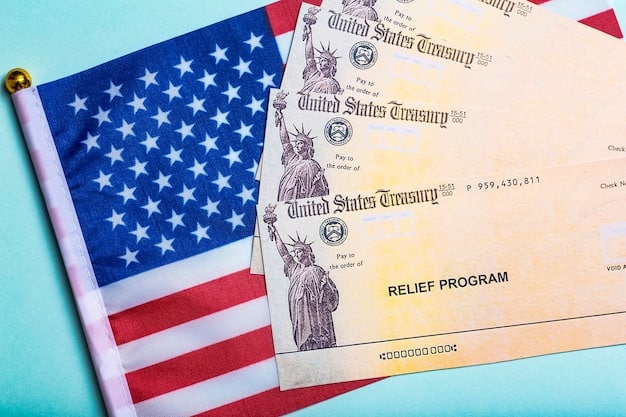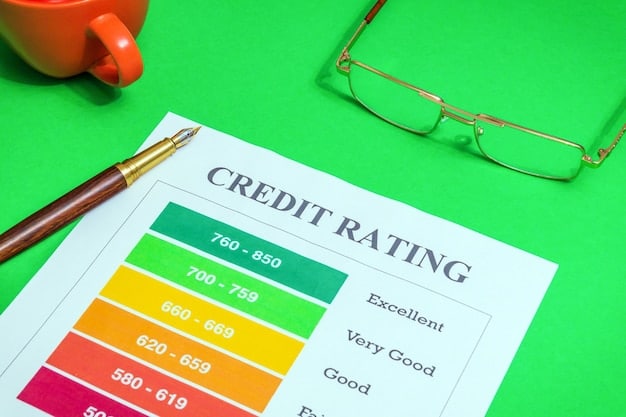High-Yield Bonds: Your 2025 Passive Income Alert

High-yield bonds offer a potent avenue for passive income in 2025, providing investors with fixed-income streams, though it is crucial to weigh potential returns with underlying risks like credit quality and market volatility.
Ready to explore a reliable source of passive income? The world of high-yield bonds might just be what you’re looking for. Stick around as we delve into how you can leverage these bonds to build a steady stream of income in 2025, all while understanding the risks involved. Let’s get started on your journey to financial independence with Passive Income Alert: Maximize Returns with High-Yield Bonds – Updated for 2025.
Understanding High-Yield Bonds
High-yield bonds, often called “junk bonds,” are debt securities issued by companies or entities with lower credit ratings. These bonds offer higher interest rates compared to investment-grade bonds as compensation for the increased risk of default. While the term “junk bond” may sound unappealing, these bonds can play a strategic role in a diversified income portfolio.
Understanding high-yield bonds requires looking into their fundamental qualities, who issues them, and how they function in the larger economy.
What Makes Them High-Yield?
The “high-yield” designation stems from the elevated risk associated with these bonds. Rating agencies like Moody’s and Standard & Poor’s assign credit ratings to bonds, reflecting their assessment of the issuer’s ability to repay the debt. Bonds rated below investment grade (BBB- or Baa3) are considered high-yield, thus requiring a higher interest payment to attract investors.
Who Issues High-Yield Bonds?
Companies that are rapidly growing, undergoing restructuring, or have a leveraged balance sheet often issue high-yield bonds. These entities might not qualify for investment-grade ratings, which makes high-yield bonds a viable financing option for them. Municipalities or even certain countries with less stable economies can also issue these bonds.
- Corporate Issuers: Companies needing capital for expansion or acquisitions.
- Restructuring Entities: Businesses undergoing financial turnaround.
- Emerging Markets: Countries seeking international investment.

In essence, understanding high-yield bonds involves recognizing their higher risk profile. Their use, the types of issuers involved, and the ways they can fit within a portfolio are useful for investors looking to increase their passive income streams.
The Appeal of Passive Income Through Bonds
One of the primary attractions of high-yield bonds is their potential to generate passive income. Passive income refers to earnings derived from an investment or business activity that requires minimal daily effort. Bonds, in particular, serve as an excellent instrument for this purpose, offering a regular income stream paid out as interest over the bond’s term.
Passive income via bonds offers stable returns and reliability, with a few strategic planning insights.
Consistent Interest Payments
Bonds provide a predetermined interest rate, also known as the coupon rate, which is paid out at regular intervals, typically semi-annually or annually. This predictability allows investors to forecast their income and plan accordingly.
Relatively Low Maintenance
Once a bond is purchased, there isn’t much active management required. Unlike stocks or real estate, bond investments don’t necessitate constant monitoring of market conditions or routine upkeep. You simply collect your interest payments until the bond matures.
Managing Risk
Despite the relative simplicity, it’s vital to monitor the financial health of the bond’s issuer. Credit rating downgrades or adverse news can impact the bond’s value and increase the risk of default.
- Diversification: Spread your bond investments across different issuers and sectors.
- Credit Research: Monitor the credit ratings and financial health of issuers.
- Economic Awareness: Stay informed about broader economic trends that can affect bond values.
The allure of generating passive income through bonds is strong, given their consistent returns and low maintenance. Strategic planning and a solid understanding of risk will help guarantee long-term profitability and stability from these investments.
Evaluating High-Yield Bonds: Key Metrics
Evaluating high-yield bonds requires an investor to scrutinize several key metrics and factors to assess their potential and risk. These metrics provide insights into the financial health of the issuer and the bond’s attractiveness relative to others in the market. By reviewing these indicators, investors are better prepared to make wise judgments about creating passive income streams.
A few important criteria should influence your decisions if you want to invest. In order to determine if a high-yield bond is valuable, keep the following in mind:
Credit Ratings
Credit ratings, assigned by agencies like Moody’s, Standard & Poor’s, and Fitch, are crucial indicators of creditworthiness. They reflect the agency’s assessment of the issuer’s ability to meet its financial obligations. Bonds with ratings below investment grade (BBB- or Baa3) are considered high-yield.
Yield to Maturity (YTM)
YTM is the total return an investor can expect to receive if they hold the bond until it matures. It considers both the bond’s current market price, par value, coupon interest rate, and time to maturity. A higher YTM indicates a potentially more lucrative investment, but also higher risk.
Financial Ratios
Analyzing the issuer’s financial statements helps gauge its financial health. Key ratios to consider include:
- Debt-to-Equity Ratio: Measures the company’s leverage.
- Interest Coverage Ratio: Indicates the company’s ability to pay interest expenses.
- Current Ratio: Assesses the company’s short-term liquidity.

In order to carefully assess the financial potential, one must also consider the wider economic environment and trends. All of these criteria are essential for choosing high-yield bonds that effectively integrate into a passive income strategy, emphasizing security and returns.
Risks Associated with High-Yield Bonds
Investing in high-yield bonds is not without its risks, and understanding these risks is crucial for managing your investment effectively. While the higher yields can be attractive, they come with a greater potential for losses. Forewarned is forearmed, as the saying goes, and recognizing the risks can help investors mitigate them.
Some of the significant dangers that come with buying high-yield bonds are shown below. Prudent investors will learn how to spot them and lessen their effects.
Credit Risk
Credit risk, also known as default risk, is the primary concern with high-yield bonds. It refers to the possibility that the issuer may be unable to make timely interest payments or repay the principal at maturity.
Interest Rate Risk
Interest rate risk is the risk that changes in interest rates will affect the value of a bond. When interest rates rise, the value of existing bonds typically falls because new bonds are issued with higher coupon rates.
Liquidity Risk
Liquidity risk refers to the ease with which a bond can be bought or sold in the market without significantly affecting its price. High-yield bonds, especially those issued by smaller companies, may have lower trading volumes, making them less liquid than investment-grade bonds.
- Diversification: Spread your investments across a variety of issuers and sectors.
- Due Diligence: Thoroughly research the issuer’s financial health and market position.
- Professional Advice: Consult with a financial advisor who can provide tailored advice.
Mitigating the risks associated with high-yield bonds requires a proactive approach. Thorough research, diversification, and professional advice can help investors make informed decisions and manage their risk exposure effectively. Always consider your own risk tolerance and financial goals before investing.
Strategies for Maximizing Returns in 2025
To maximize returns in 2025 from high-yield bonds, investors should adopt a comprehensive strategy incorporating current market trends, risk management techniques, and a forward-looking approach. The right strategy, in 2025, can make a significant difference in achieving optimal results from your investment.
Investors may maximize their returns on high-yield bonds in 2025 by using certain methods, such as:
Focus on Sector Selection
Certain sectors tend to perform better than others in specific economic environments. Understanding these dynamics is crucial for optimizing returns. For example, in a growing economy, sectors like technology and consumer discretionary might outperform defensive sectors like utilities.
Active Management Approach
An active management approach involves regular monitoring and adjustments to your bond portfolio based on market conditions and issuer-specific developments. This may include rebalancing your portfolio to take advantage of opportunities or reduce risk.
Tax-Efficient Investing
Consider the tax implications of your bond investments. Investing through tax-advantaged accounts, such as 401(k)s or IRAs, can help reduce your tax burden and increase your overall returns.
- Stay Informed: Keep abreast of the latest economic news and market trends.
- Seek Professional Advice: Work with a financial advisor to develop a personalized investment strategy.
- Be Patient: Investing in high-yield bonds is a long-term game.
By combining strategic sector selection, active portfolio management, and tax-efficient investing, you can enhance your return potential and achieve your financial goals with high-yield bonds.
The Future of High-Yield Bonds in Passive Income
Looking forward, the role of high-yield bonds in generating passive income is expected to evolve, influenced by economic trends, regulatory changes, and technological advancements. Investors who stay informed and adapt to these changes will be best positioned to capitalize on opportunities.
The following are some trends and factors that will affect how high-yield bonds produce passive income in the future:
Economic Outlook
The overall health of the economy will significantly impact the high-yield bond market. Factors such as GDP growth, inflation, and interest rates will influence bond yields and credit spreads. Investors need to monitor these indicators to make informed decisions.
Regulatory Landscape
Changes in regulations can also affect the high-yield bond market. New rules related to capital requirements, disclosure, or trading practices can impact bond liquidity and pricing. Staying abreast of regulatory developments is essential.
Technological Innovations
Technological advancements are transforming the financial industry, including the bond market. Fintech platforms are making it easier for investors to access and trade high-yield bonds. Artificial intelligence (AI) and machine learning are being used to analyze credit risk and identify investment opportunities.
- Continuous Learning: Stay updated with market trends and regulatory changes.
- Embrace Technology: Utilize fintech tools and AI-driven analytics for informed investment decisions.
- Diversify Strategically: Build a diversified portfolio that mitigates risk.
The future of high-yield bonds in passive income generation looks promising for investors who are proactive, informed, and adaptable. By understanding key trends and embracing new technologies, you can position yourself for success in the evolving bond market.
| Key Point | Brief Description |
|---|---|
| 💰 High-Yield Bonds | Offer higher returns due to greater credit risk. |
| 📈 Key Metrics | Include credit ratings, YTM, and financial ratios. |
| ⚖️ Risks | Credit, interest rate, and liquidity risks are crucial. |
| 🎯 Strategies | Focus on sector selection, active management, and tax efficiency. |
FAQ Section
▼
High-yield bonds, also known as junk bonds, are debt securities issued by companies with lower credit ratings. These bonds offer higher interest rates compared to investment-grade bonds, compensating investors for the increased risk of default.
▼
Yield to maturity (YTM) is the total return an investor can expect to receive if they hold the bond until it matures. It considers the bond’s current market price, par value, coupon interest rate, and time to maturity. A higher YTM indicates a potentially more lucrative investment with higher risk.
▼
Key ratios to consider include the debt-to-equity ratio, which measures a company’s leverage; the interest coverage ratio, which indicates the company’s ability to pay interest expenses; and the current ratio, which assesses the company’s short-term liquidity.
▼
Credit risk, or default risk, is the possibility that the issuer won’t be able to make timely interest payments or repay the principal at maturity. This is a primary concern with high-yield bonds because of the lower credit ratings of the issuing companies.
▼
You can mitigate risks by diversifying your investments across various issuers and sectors, conducting thorough due diligence on the issuer’s financial health, staying informed about market trends, and seeking advice from a financial advisor before investing.
Conclusion
In conclusion, high-yield bonds can be a valuable component of a passive income strategy in 2025, offering potentially attractive returns. However, it’s essential to understand and manage the associated risks through careful evaluation, diversification, and informed decision-making. By staying proactive and adapting to market changes, investors can leverage high-yield bonds to achieve their financial goals.





